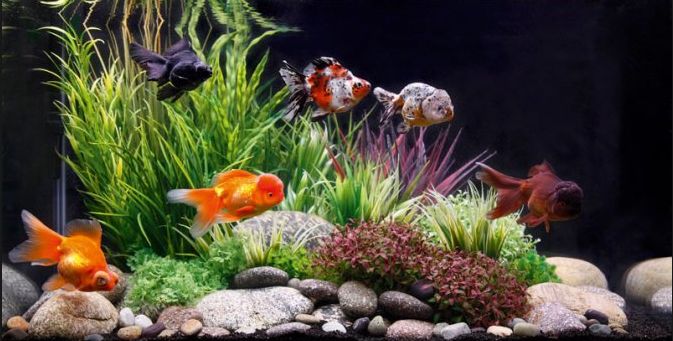
Goldfish Care
The common narrow bodied goldfish are simply the easiest fish there is to keep due to hundreds of years of “inadvertent selective breeding”. Yet well meaning but ill-informed individuals on social media will tell the hobbyist that goldfish are very touchy fish that requires a great deal of careful care. This is because of a concerted effort by PETA to stop the keeping of goldfish in aquariums. So the true story is exactly the opposite of the story one finds on social media. Welcome to the world of the internet.
Let us make one thing very clear:
.
Keeping Common Goldfish is EASY!
.
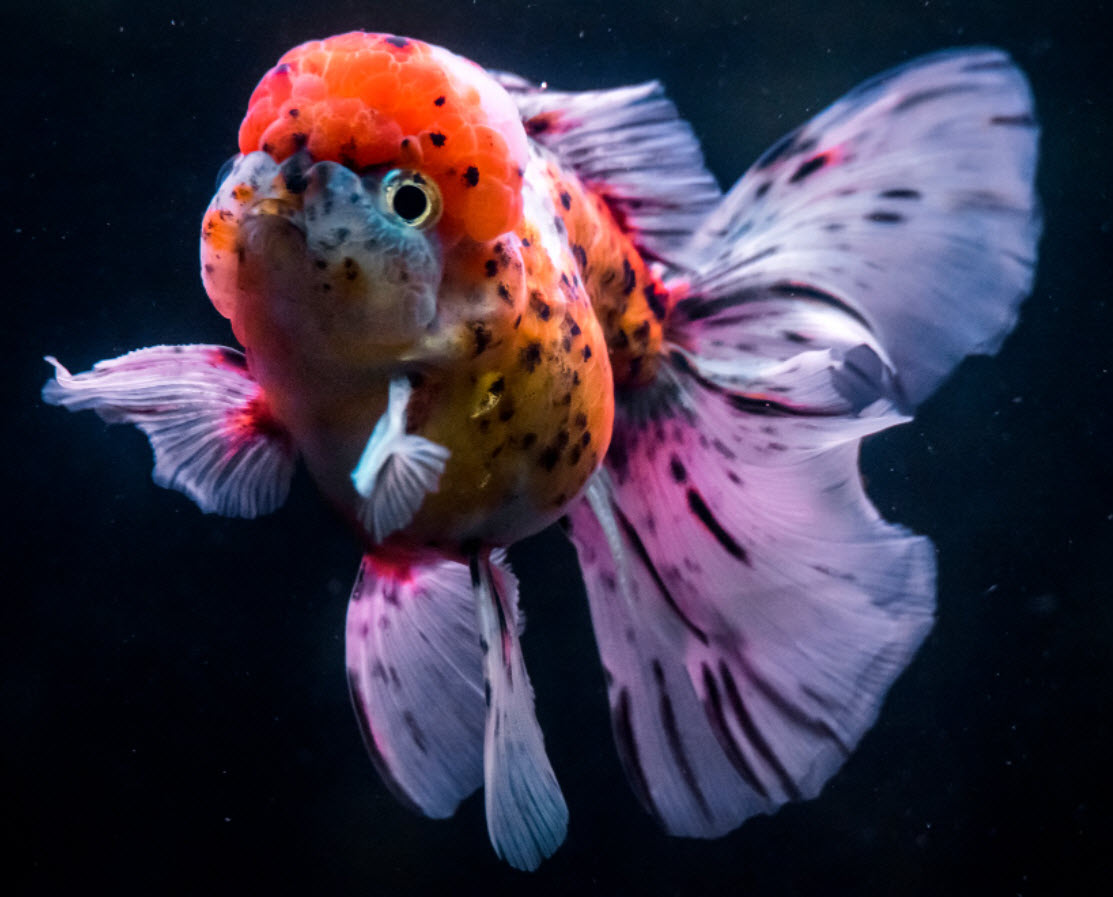
But all hobbyist’s want to make their fish healthy and “thriving”. There are five parameters that are key to achieving that. They are:
-
Have excellent biofiltration with lots of filter media surface area
-
Feed very lightly (2 eyeball’s worth of dry food once a day)
-
Feed food with a protein level over 40% on a dry basis
-
Have great aeration of the water
-
Infrequently clean the filter while leaving a lot of brown gunk
Note that these five things together should produce crystal clear water. Crystal clear water has a very low bacterial count in the water. Crystal clear water indicates conditions which where fish will be very healthy.
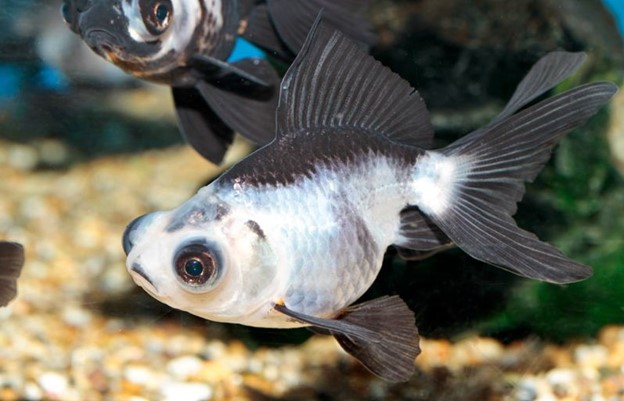
Goldfish in Warm Water
One common misconception is that goldfish cannot be kept in warm water aquariums. Goldfish are carp. Carp are fish which can not only live, they will THRIVE in an incredibly wide range of water temperatures and water chemistries, including warm water.
And goldfish are descended from fish which live for most of the year in warm water subtropical conditions in southern China. Per “Origin of Chinese Goldfish and Sequential Loss of Genetic Diversity Accompanies New Breeds” Wang et. al, 2013:
“Chinese goldfish have a matrilineal origin from native southern Chinese C. a. auratus, especially the lineages from the lower Yangtze River”
I.e. per DNA analysis, goldfish descend from a carp, Carassius auratus, which lived in the lower Yangtze River in China. The Yangtze river is a subtropical river at the same latitude as Florida. Goldfish are fine even in 95o water.

In south Florida there are thousands of fish ponds which house millions of goldfish which do just fine in water which is 85 to 95 degrees Fahrenheit six months out of the year. They breed goldfish there.
That being said, fish are “eurythermic”. “Eurythermic” creatures have metabolisms which are dependent on the temperature. So a goldfish in warm water will have a higher metabolism than a goldfish in cold water and it will generally live a shorter life. But there is nothing to indicate this means a unhealthy or pain filled life.
And, because the Carassius auratus carp is very adaptable, the same goldfish can live in ponds in Ohio where the water freezes over in the winter. This wide range of temperature is just very difficult for many to wrap their heads around. But the carp species, Carassius auratus, from which goldfish have evolved is found from tropical Vietnam all the way to Siberia. And fish from Siberia that are Carassius auratus thrive if taken to a pond in Vietnam.
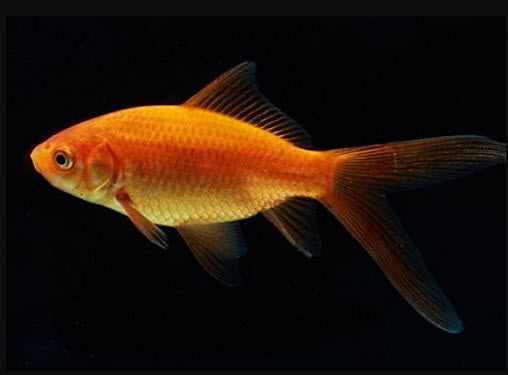
The website “Advanced Aquarium Concepts” said the following about the myth that goldfish are a cold water fish:
This isn’t completely a myth, goldfish are definitely well adapted to temperate climates, commonly called cold water. They can live in water down to the freezing point, as long as it stays liquid. The myth part of this is that they can only be in cold water. This is not true. They are actually eurythermal, which means they can thrive in a wide range of temperatures. Fishbase.org has their temperature range listed as 0-41C (32-105.8F).
It is important to distinguish between truly cold water fish and those who can thrive in warmer temperatures as well. Truly cold water fish are species that cannot thrive in warmer temperatures. The increased temperature causes stress, failure to thrive, and can even kill them. This would include species like trout and white cloud mountain minnows. These are species that when in higher temperatures show signs of stress such as reduced coloration, overall failure to thrive, and more extremes such as severe stress, illness, and death.
This is not the case with goldfish. This is not a case of goldfish simply tolerating higher temperatures than they are given credit for, they thrive in these temperatures just as well as they do in lower temperatures. In higher temperatures goldfish do not show these signs of stress and failure to thrive. They can thrive in higher temperatures.
Goldfish are not a “cold water” fish, they are an “all water” fish.
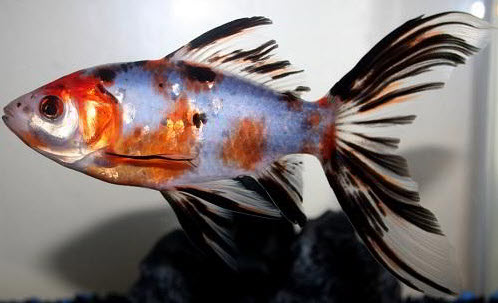
Now as in all things there is that wonderful la-la land that some people live in. When the research above was quoted on social media, one individual on social media said there were “forty papers” that said goldfish were a cold water fish. So we asked her for one author and paper title which said this. She didn’t come back. They never do. There are no such research papers.
And goldfish, much like all fish actually, can survive very rapid changes in water temperature quite easily. This mantra of “stability” and “consistency” in fish keeping is just one huge myth that just keeps being parroted by every well meaning but ill-informed individuals on social media on the web and YouTube. To go into this in more detail click on this link:
4.8. “Stability” isn’t Important
.

The Myth That Goldfish get “Lonely”
Note that goldfish don’t get “sad”, “happy”, withdrawn” or “depressed” when they have no companion fish. Like ALL fish they only get “stressed”, where a stress hormone is produced which is bad for them over time (scientists can measure the stress hormone in fish). Schooling fish will produce stress hormone when isolated and “alone”.
But goldfish are carp and NOT a schooling fish. So they will not produce stress hormones in response to being “alone”. They can act differently when alone as compared to when they are with another goldfish but there is no “emotion” involved. When there are two or more of any fish there will be something called “dominance” behavior which is different from when the fish are alone. But the behavior has nothing to do with “emotions”. Attributing emotions to fish is the common practice of anthropomorphism and not supported by the science.
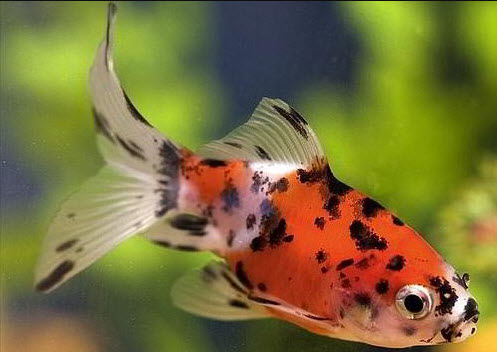
Aeration
Aeration is important for all fish in an aquarium, including goldfish. Goldfish can live in aquariums with poor aeration but they will be susceptible to disease in low oxygen conditions. There are two ways to achieve good aeration;
- Have choppy waves at the surface if the water, either from a wavemaker or the outlet of a filter.
- Have something like airstones creating a lot of bubbles
Many aquariums with goldfish health problems that are shown in photos on social media have very still water surfaces. Some even have a protein skim on the surface of the water. And these folks come on social media wondering why they have disease problems when “their water parameters are perfect”. Still water is poorly aerated water. and poorly aerated water is disease filled water. More on the topic of aeration at this link:
9.1. Aeration
.
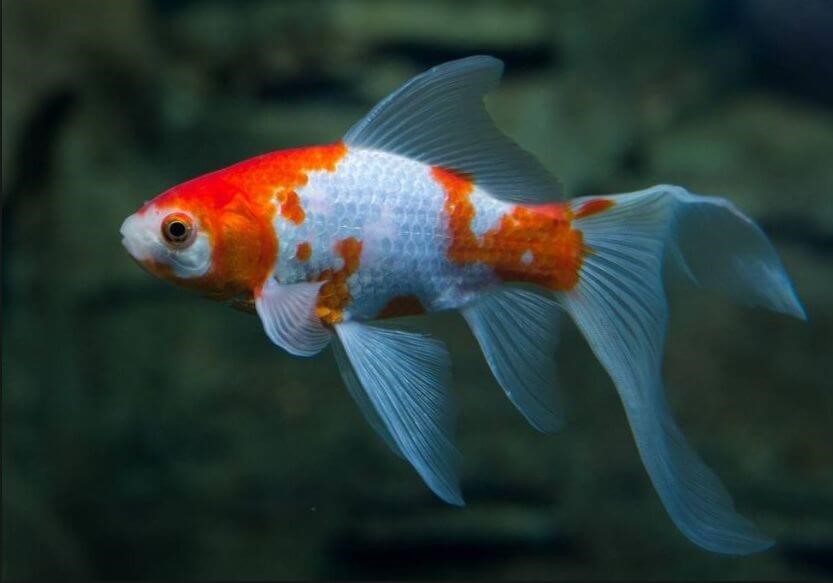
Water Quality
Because goldfish were raised for thousands of generations in very foul conditions of either wood bins, ceramic bowls or small, overstocked ponds by the Chinese, they are very adaptable to what water parameters they need. They can take nitrate levels of over 2,000. And they can take surprisingly high ammonia and nitrite in stride. The yellow levels and even the pink levels in the chart below can be easily survived even by fancy goldfish.
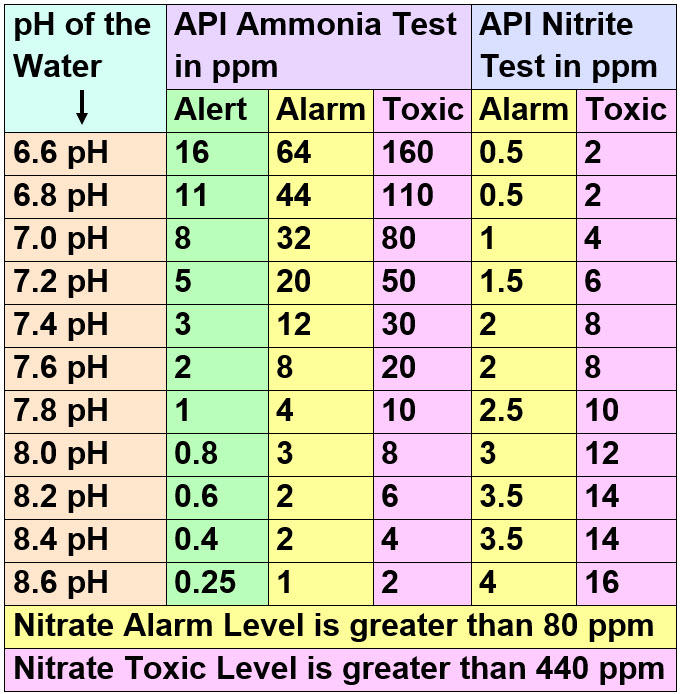
Now we do decidedly recommend that one keep ammonia at or below 0.25, nitrite at zero and nitrate below 80 ppm for goldfish. These levels indicate a healthy ecosystem in the aquarium. And a healthy ecosystem with crystal clear water will always give one the healthiest fish possible. But this is NOT a “requirement”.
Goldfish in Mixed Biotopes
Many say common goldfish can’t live in mixed biotope aquariums. That is simply just another myth. Goldfish are very adaptable to ALL temperatures, ALL water chemistries and ALL fish food. They are probably the most adaptable fish there is.
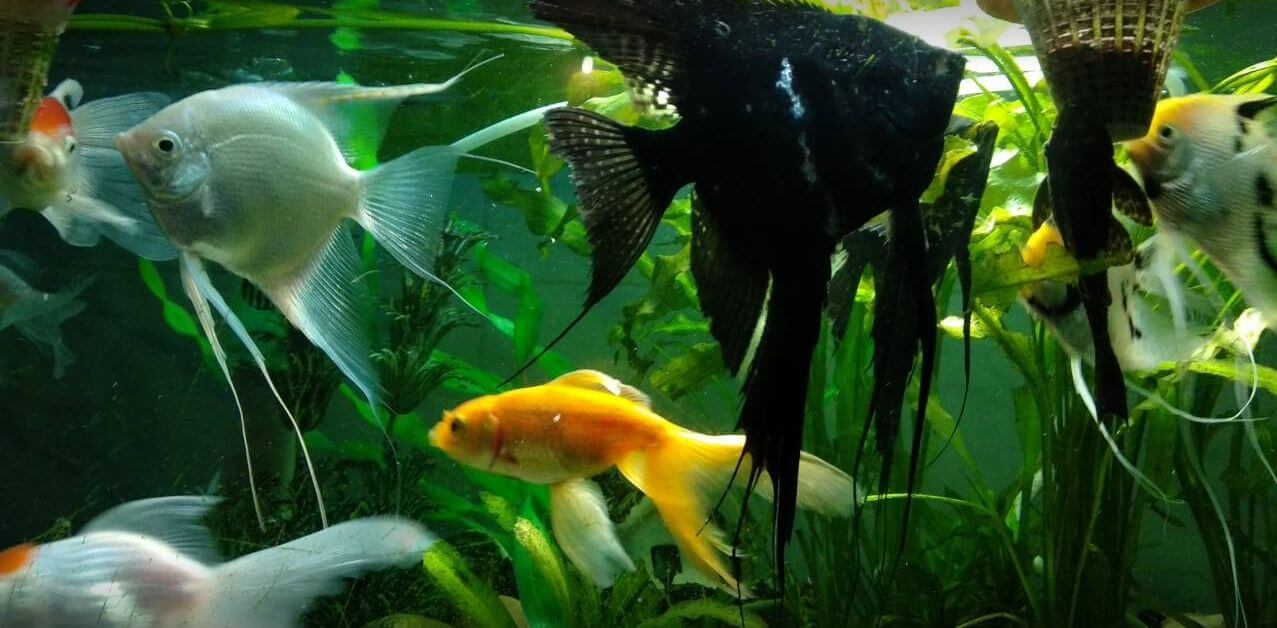
And they can live with any peaceful fish that they can’t eat or can’t eat them. They typically don’t do well with aggressive aquarium fish, like in a Lake Malawi mbuna tank. But it should be noted one Facebook hobbyist had an established aquarium where there were several goldfish doing very well with some mbuna, including the very aggressive Melanochromis auratus.
Also note that any fish’s mouth can eat something two to four times the size of the mouth as the jaws can come “unhinged”. I have personally seen a four inch goldfish eat a golden barb who was at least 3/8 th of an inch in diameter and over one inch in length! So don’t underestimate the ability of goldfish to eat smaller fish.
And the old myth that goldfish don’t do well at the temperatures of a tropical tank is debunked at length above.
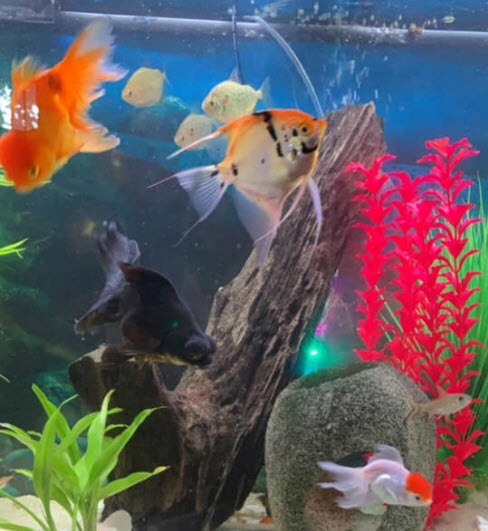
Angels and Goldfish (this aquarium had been like this for over three years!).
Here is another long standing mixed aquarium which worked very well:
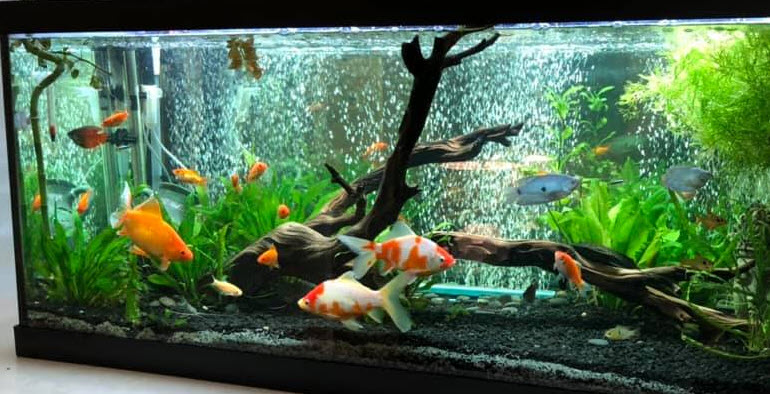
Goldfish, gouramis, rainbowfish, tetras and platies all doing very well together. For a really imaginative combination look at this aquarium:

Goldfish Diet
Again, due to the fact that the Chinese fed them many different foods for one thousand years, goldfish have the most tolerance of food variations of all fish. This is once again “inadvertent selective breeding”. But I do not recommend one feed goldfish “goldfish food”. I find the protein level too low and the filler level of most goldfish food to be too high for even goldfish. Feed goldfish a cichlid food or a community food.
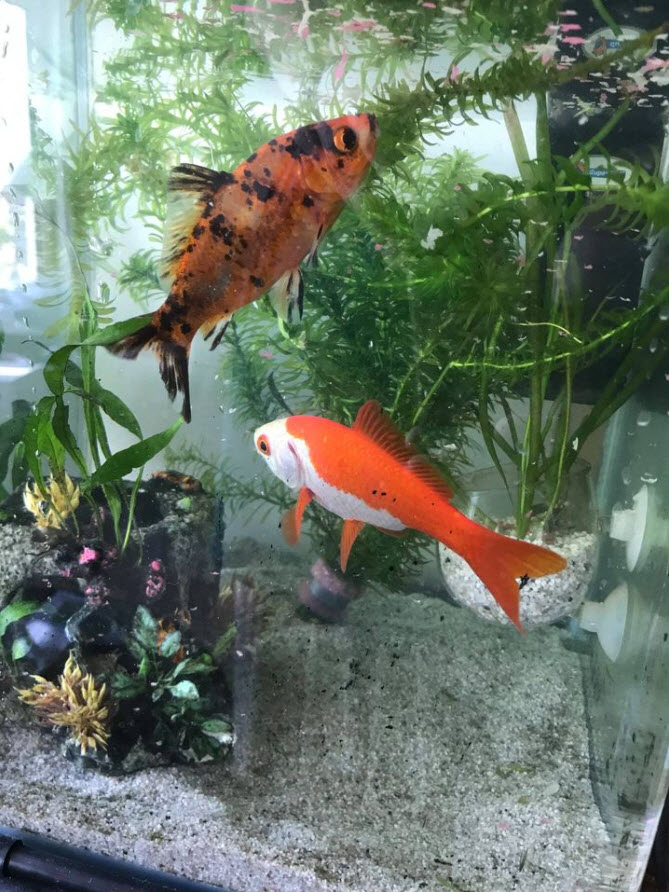
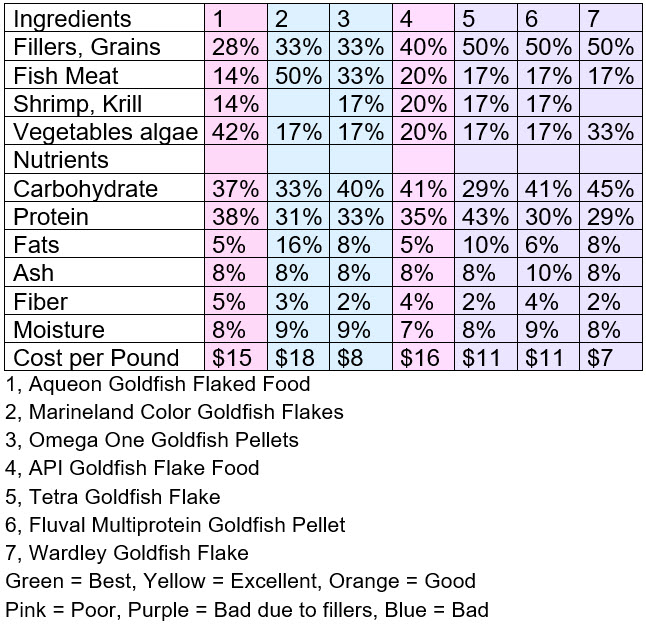
This chart is based on the protein level of the food
- Green best >50% protein
- Yellow excellent 45-49% protein
- Orange good 40-44% protein
- Pink poor 35-39% Protein
- Blue bad 30-35% protein
- Purple bad >50% filler
The recommended diet for goldfish is simple:
- a dry food with greater than 40% protein
- roughage in the form of whole vegetables like spinach leaves, zucchini, green beans, etc. at least once a week
The higher the protein level in the food the faster the feces of the fish will decompose. The lower the carbohydrate level the less there will be a build up of “brown gunk” in the substrate due to something called the “carbon to nitrogen ratio”. So I always recommend a high protein community food for goldfish. The higher the protein level the better for the goldfish.
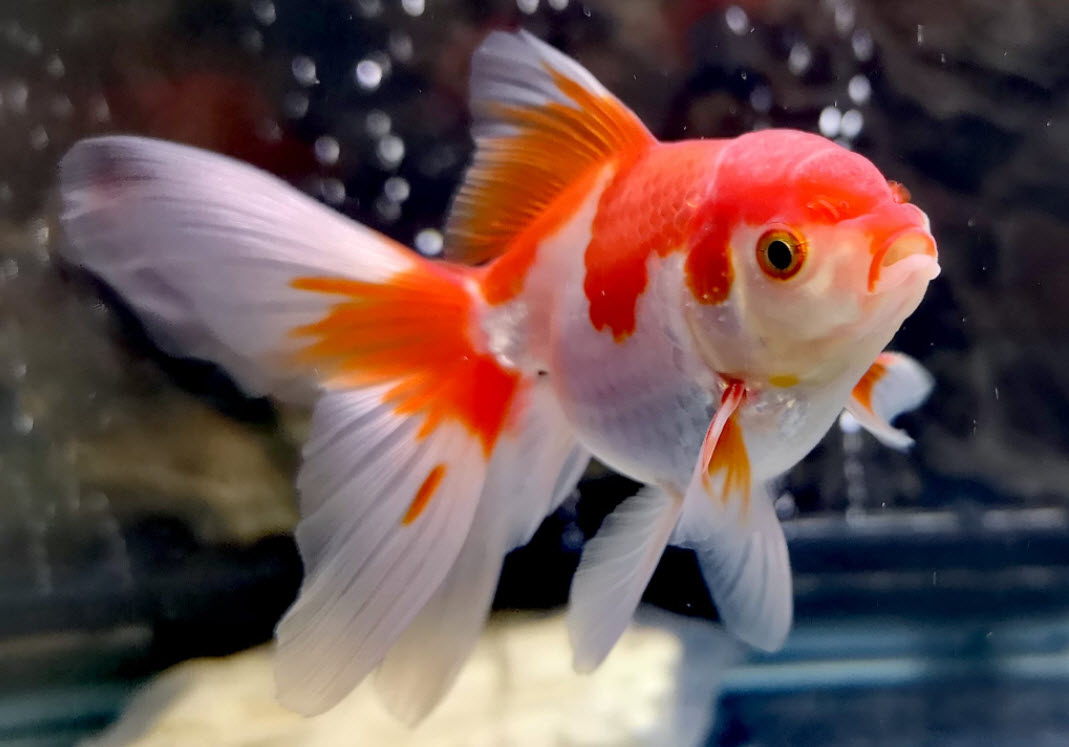
In any case it turns out that all fish can eat just about anything. All the concern about food and whether a fish is an herbivore or a carnivore is unfounded. Here is a link to an article discussing that topic:
3.1. Insignificance of Food
And goldfish can be fed frequently or rarely, it makes little difference. The more often and the more food one feeds the faster the growth. But the less often and the less one feeds the healthier a goldfish will be. It is recommended to feed 3% of the body weight every day once a day for juveniles, 1% once a day for adults. If you are a perfectionist, here is a link on how to calculate how much to feed a fish:
3.3. Amount of Fish Food
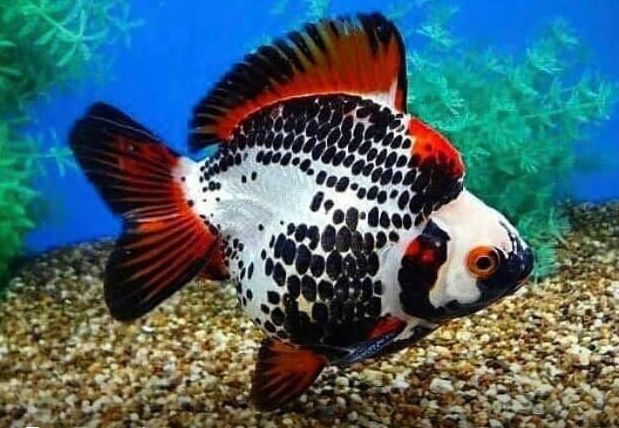
Goldfish Substrate
There have been several posts on social media where supposedly a goldfish has swallowed a grain of gravel and “choked to death”. There are several issues with this idea. First off fish can’t “choke”. They breath through gills which cannot be obstructed by a grain of gravel.
Secondly, as mentioned above, I have personally seen a four inch goldfish eat a golden barb who was at least 3/8 th of an inch in diameter and over one inch in length. Fish have extensible jaws and very easily expanded gullets and stomachs and can eat very large prey whole, just like reptiles, amphibians and birds. So it is very doubtful a grain of gravel could block the gullet.

A far more likely explanation is that the goldfish had an intestinal blockage (hexamita, worms and bacteria often cause this in fish). The affected goldfish was expanding its jaws like it was choking in response to the blockage. And the fish died. And the gravel got blamed.
Also the “jaw” of a fish is a very complicated structure with many interlocking pieces. Sometimes these pieces “lock” in place. This will look like a fish which is “choking” on something. This is not “choking”.
I always ask people on social media who claim to have lost a goldfish to “swallowing gravel” if they found a piece of gravel in the gullet of the dead fish. The answer invariably is “I didn’t look”, if they answer at all. I use aquarium gravel and under-gravel filters in all my many tanks and always have done that. I’ve had many goldfish in such aquariums with no problems evident. So I put “choking on gravel” in the myth category.
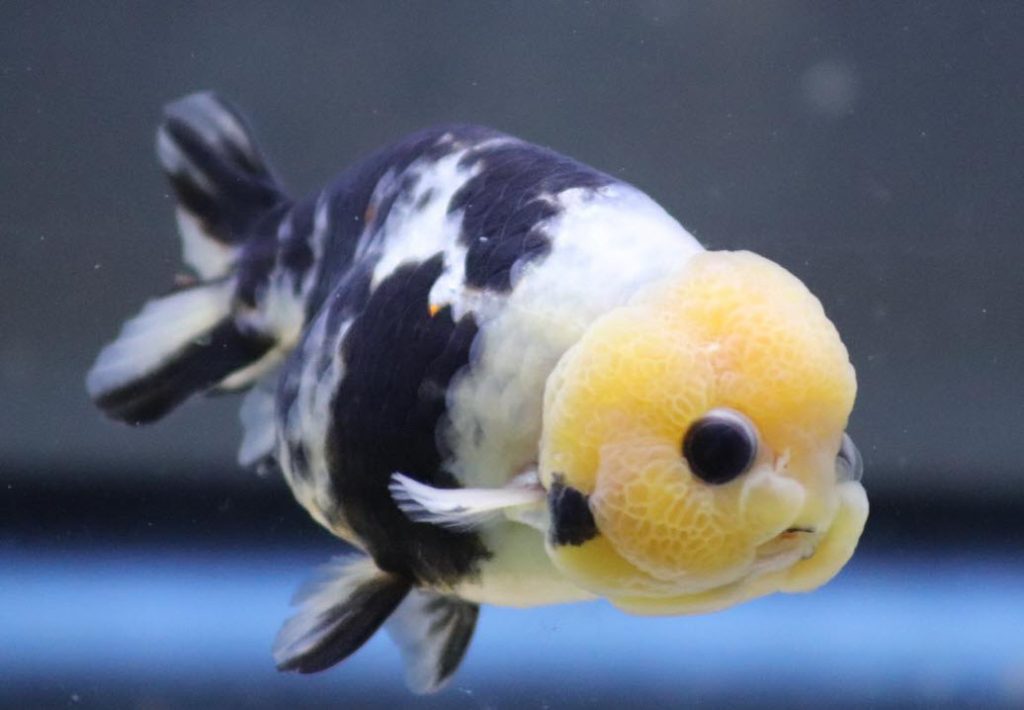
Light is not a Factor in Goldfish Color
One often repeated myth is that goldfish requires light to maintain their color. Color in fish is determined largely by genetics and age, not by the amount of light they get. Once again, the Chinese kept the goldfish inside in small bowls with very poor lighting and no sunlight. And these same fish were bred to have good color as long as possible.
And the concept is that the UV light in sunlight creates stronger colors in goldfish, just like UV causes tanning in Caucasian humans. While this may be true to a slight extent in goldfish, there is no safe way to add UV light to an aquarium to bath the fish with UV light, UV light being damaging to the human eye. So the discussion is largely academic.

Goldfish do typically change their coloration as they get older. This change is very unpredictable. It is common for orange fish to become white as they age. Some goldfish turn from orange to white in one year. Some goldfish take fifteen years to turn white.
Still other variations of goldfish go from gold to orange and black as they age. And some breeds like black moors change from black to a black/gold coloration while relatively young. Putting black moors in strong light will not have any effect on this process.
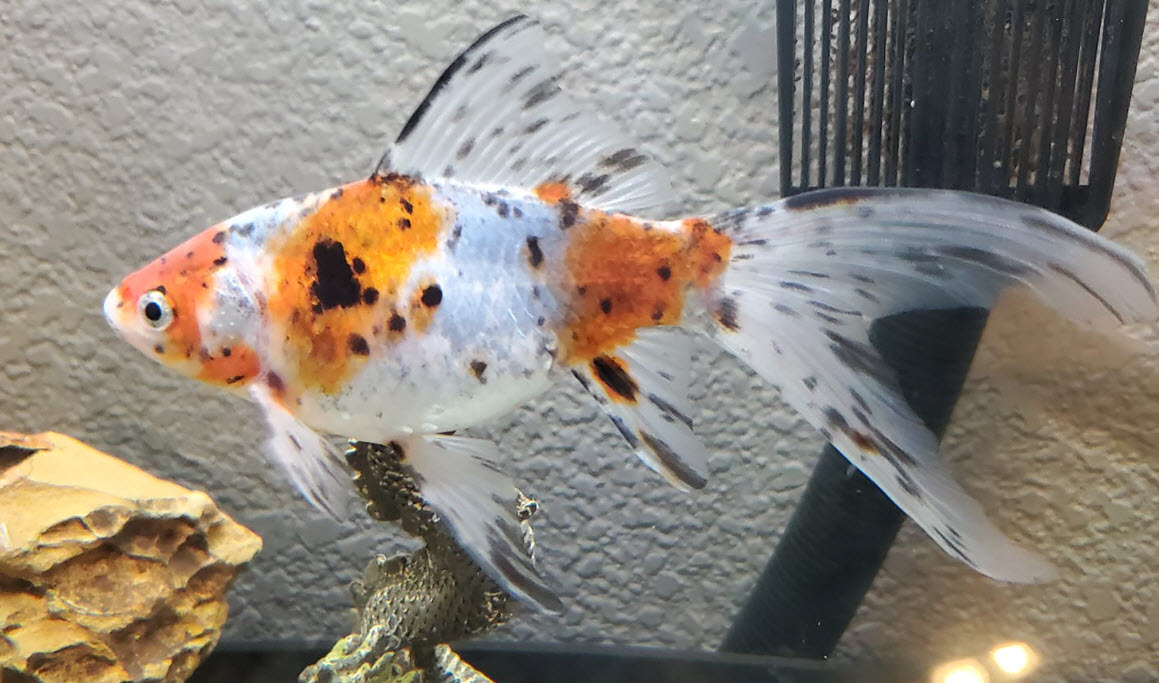
Further Articles on Goldfish
For those wanting to delve deeper into keeping goldfish one can go to the following links:
17.5.1. Types of Goldfish
17.5.2. Size of Goldfish
17.5.3. Stocking Goldfish
.
Return to the Goldfish Main Menu
.
Aquarium Science Website
The chapters shown below or on the right side in maroon lead to close to 400 articles on all aspects of keeping a freshwater aquarium. These articles have NO links to profit making sites and are thus unbiased in their recommendations, unlike all the for-profit sites you will find with Google. Bookmark and browse!
.

Dave says
In reply to Jeck ….. It is a myth that goldfish “choke” on gravel. Any size gravel or sand is just fine.
Jeck says
Hi! Is it safe to keep goldfish on sandy soil with a fraction of < 1 mm?
Barbara Andersen says
Aquarium Science was recommended to me by someone in a goldfish group on FB. Up to now I was seeing advice and comments obviously based on those mentioned here as generating from PETA or similar. Having myths debunked has increased my options for fish keeping many fold and I thank you for this. I have an innate awareness – as I’m sure most people do, when something is ‘fishy’ and that’s why I felt sure that there must be better, science-based information available and now I’ve found it. Thank you.
Dave says
In reply to Jimmy …. Goldfish will do just fine with quarter inch gravel (1/8 to 3/8 inch, 4 mm to 9mm). Unfortunately there is no gravel at the big box stores which meet this requirement. The big box stores only have pea gravel which is much too large.
Jimmy says
If I choose to go with undergravel filter, what gravel size should I use for goldfish? Are there any cheap gravel options at Home Depot or Lowe’s that are suitable for undergravel filter for goldfish? Thank you.
Andrew says
First of all, thank you for this site. I very much appreciate some evidence based aquarium advice targeted towards the hobbyist. There are no studies paid for on hobby aquariums; because they would all damage the parts of the industry that make money.
That being said, ironically, I wanted to share one anecdote as a long term goldfish keeper and disagree with one point.
Choking on gravel- The myth part of this is more of a misnaming of the issue. I’ve had issues with .5cm rocks and goldish, not because they choke, but because as the goldfish is scavenging and sucking gravel in and out the jaws can become locked around a piece of gravel. and it cannot be dislodged. It seems to be fairly common.
I took the watch and wait approach with my fish when this happened; for days. Ultimately, it took a pair of tweezers and a lot of very delicate maneuvering to remove it. After it happened a second time, the substrate had to go. So now I only do either no substrate, very small, or very big rocks. I’m fairly sure this is what people are referring to.
I think you could make an eyeball rule for this one as well. Goldfish substrate should either be
less than half the size of their eyeball, or more than double the size of their eyeball.
Amit Kumar says
Thanks for your response Dave! Much obliged.
Dave says
In reply to Amit Kumar …. You can feed that as a steady diet to goldfish
Amit Kumar says
Hi,
I have the option to buy freeze dried Arctic Shrimp with the following Nutritional composition:
Crude Protein: 60% | Crude Fat: 7% | Crude Fiber: 2% | Moisture: 5%
I am not sure if 60% protein will be fine with goldfish. Please advise.
Is this good to feed daily, or only as once a week treat?